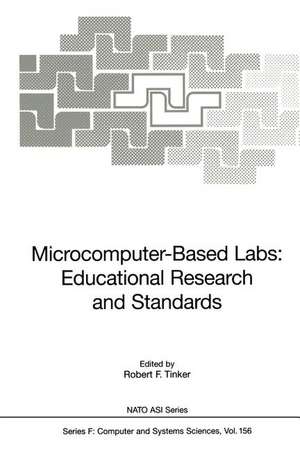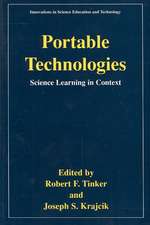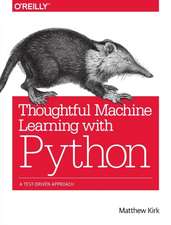Microcomputer-Based Labs: Educational Research and Standards: NATO ASI Subseries F:, cartea 156
Editat de Robert F. Tinkeren Limba Engleză Paperback – 16 sep 2011
Din seria NATO ASI Subseries F:
- 20%
 Preț: 650.27 lei
Preț: 650.27 lei - 20%
 Preț: 668.55 lei
Preț: 668.55 lei - 20%
 Preț: 992.44 lei
Preț: 992.44 lei - 18%
 Preț: 1239.19 lei
Preț: 1239.19 lei - 20%
 Preț: 1922.81 lei
Preț: 1922.81 lei - 20%
 Preț: 654.37 lei
Preț: 654.37 lei - 18%
 Preț: 1234.00 lei
Preț: 1234.00 lei - 20%
 Preț: 709.78 lei
Preț: 709.78 lei - 20%
 Preț: 656.03 lei
Preț: 656.03 lei - 18%
 Preț: 1854.94 lei
Preț: 1854.94 lei - 20%
 Preț: 374.97 lei
Preț: 374.97 lei - 20%
 Preț: 991.94 lei
Preț: 991.94 lei - 20%
 Preț: 671.02 lei
Preț: 671.02 lei - 20%
 Preț: 1925.96 lei
Preț: 1925.96 lei - 20%
 Preț: 994.73 lei
Preț: 994.73 lei -
 Preț: 389.49 lei
Preț: 389.49 lei - 20%
 Preț: 657.99 lei
Preț: 657.99 lei - 20%
 Preț: 655.20 lei
Preț: 655.20 lei - 18%
 Preț: 1225.31 lei
Preț: 1225.31 lei - 18%
 Preț: 952.09 lei
Preț: 952.09 lei - 20%
 Preț: 332.06 lei
Preț: 332.06 lei - 20%
 Preț: 1284.47 lei
Preț: 1284.47 lei - 20%
 Preț: 644.81 lei
Preț: 644.81 lei -
 Preț: 395.85 lei
Preț: 395.85 lei - 18%
 Preț: 1221.07 lei
Preț: 1221.07 lei - 15%
 Preț: 643.34 lei
Preț: 643.34 lei - 20%
 Preț: 645.47 lei
Preț: 645.47 lei - 20%
 Preț: 1282.98 lei
Preț: 1282.98 lei - 20%
 Preț: 656.36 lei
Preț: 656.36 lei - 20%
 Preț: 1283.31 lei
Preț: 1283.31 lei - 20%
 Preț: 1924.15 lei
Preț: 1924.15 lei - 20%
 Preț: 362.24 lei
Preț: 362.24 lei
Preț: 338.68 lei
Preț vechi: 423.35 lei
-20% Nou
Puncte Express: 508
Preț estimativ în valută:
64.81€ • 70.38$ • 54.44£
64.81€ • 70.38$ • 54.44£
Carte tipărită la comandă
Livrare economică 22 aprilie-06 mai
Preluare comenzi: 021 569.72.76
Specificații
ISBN-13: 9783642647406
ISBN-10: 3642647405
Pagini: 424
Ilustrații: XIV, 398 p.
Dimensiuni: 155 x 235 x 22 mm
Greutate: 0.59 kg
Ediția:Softcover reprint of the original 1st ed. 1996
Editura: Springer Berlin, Heidelberg
Colecția Springer
Seria NATO ASI Subseries F:
Locul publicării:Berlin, Heidelberg, Germany
ISBN-10: 3642647405
Pagini: 424
Ilustrații: XIV, 398 p.
Dimensiuni: 155 x 235 x 22 mm
Greutate: 0.59 kg
Ediția:Softcover reprint of the original 1st ed. 1996
Editura: Springer Berlin, Heidelberg
Colecția Springer
Seria NATO ASI Subseries F:
Locul publicării:Berlin, Heidelberg, Germany
Public țintă
ResearchCuprins
Origins of Innovation.- The Spread of Acceptance.- The Paucity of the Literature.- The Nature of Proof.- Standards.- Fusion of Educational Technologies.- I: Overview.- From Separation to Partnership in Science Education: Students, Laboratories, and the Curriculum.- 2. Trends and Techniques in Computer-Based Educational Simulations: Applications to MBL Design.- 3. MBL, MML and the Science Curriculum—Are We Ready for Implementation.- II: Research.- 4. Using Large-Scale Classroom Research to Study Student Conceptual Learning in Mechanics and to Develop New Approaches to Learning.- 5. A New Mechanics Case Study: Using Collisions to Learn about Newton´s Third Law.- 6. Teaching Electric Circuit Concepts Using Microcomputer-Based Current/Voltage Probes.- 7. Learning and Teaching Motion: MBL Approaches.- 8. Study of Pupils’ Skills of Graphical Interpretation with Reference to the Use of Data-Logging Techniques.- 9. On Ways of Symbolizing: The Case of Laura and the Velocity Sign.- 10. Microcomputer-Based Laboratories in Inquiry-Based Science Education—An Implementation Perspective.- III: MBL and Learning.- 11. Computer Modelling for the Young—and Not So Young—Scientist.- 12. Computer Applications in Physics: The Integration of Information Technology in the Physics Curriculum.- 13. Global Lab: From Classroom Labs to Real-World Research Labs.- 14. Dynamic Physical Representation of Real Experiments.- 15. Changing Misconceptions Through MBL—A Concept for Lab-Sessions.- 16. Teaching Mechanics Through Interactive Video and a Microcomputer-Based Laboratory.- 17. Wanting to Know: Interactive Video Providing the Context for Microcomputer-Based Laboratories.- IV: Hardware and Software Systems.- 18. The Development of a Communication Protocol for School Science LaboratoryEquipment.- 19. Software: Integration, Collaboration, Standards, and Progress.- 20. IP-Coach—A Useful Tool for Universities in Developing Countries.- 21. The CALIOPE: A Computer-Assisted Laboratory Instrument Oriented to Physics Education.- 22. Bremer Interface System: Didactic Guidelines for a Universal, Open, and User-friendly MBL System.- 23. Some Experiments in Physics Education: Using a Force Sensor Connected to a Computer.- 24. Microcomputer-Based Laboratories at A. Mickiewicz University.- 25. Microcomputer-Based Laboratory—The Observation of Light Diffraction and Interference Patterns.- List of Contributors.
Textul de pe ultima copertă
Microcomputer-based labs, the use of real-time data capture and display in teaching, give the learner new ways to explore and understand the world. As this book shows, the international effort over a quarter-century to develop and understand microcomputer-based labs (MBL) has resulted in a rich array of innovative implementations and some convincing evidence for the value of computers for learning. The book is a sampler of MBL work by an outstanding international group of scientists and educators, based on papers they presented at a seminar held as part of the NATO Special Programme on Advanced Educational Technology. The story they tell of the development of MBL offers valuable policy lessons on how to promote educational innovation. The book will be of interest to a wide range of educators in physics, science and information technology, and to educational policy makers.










